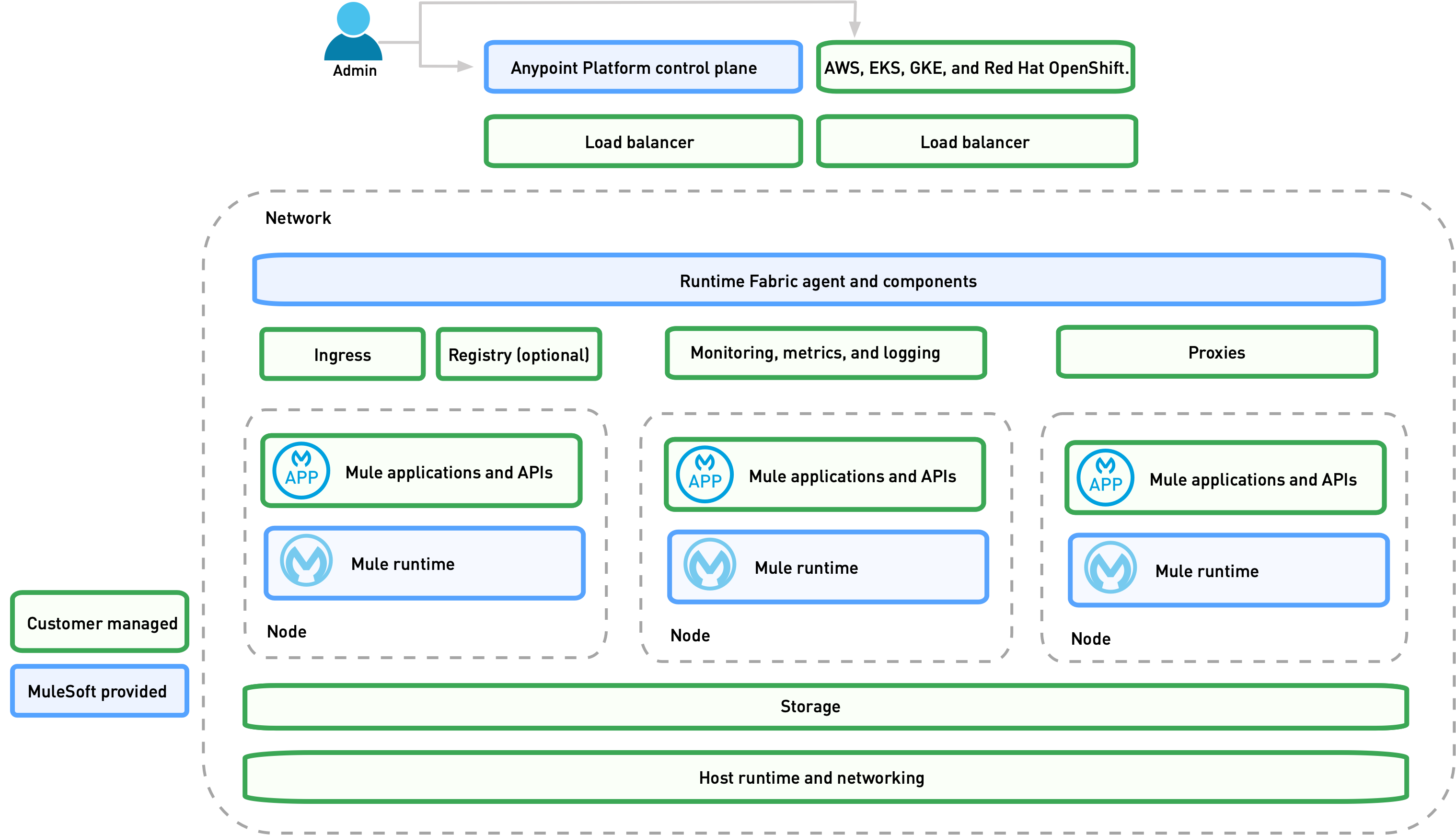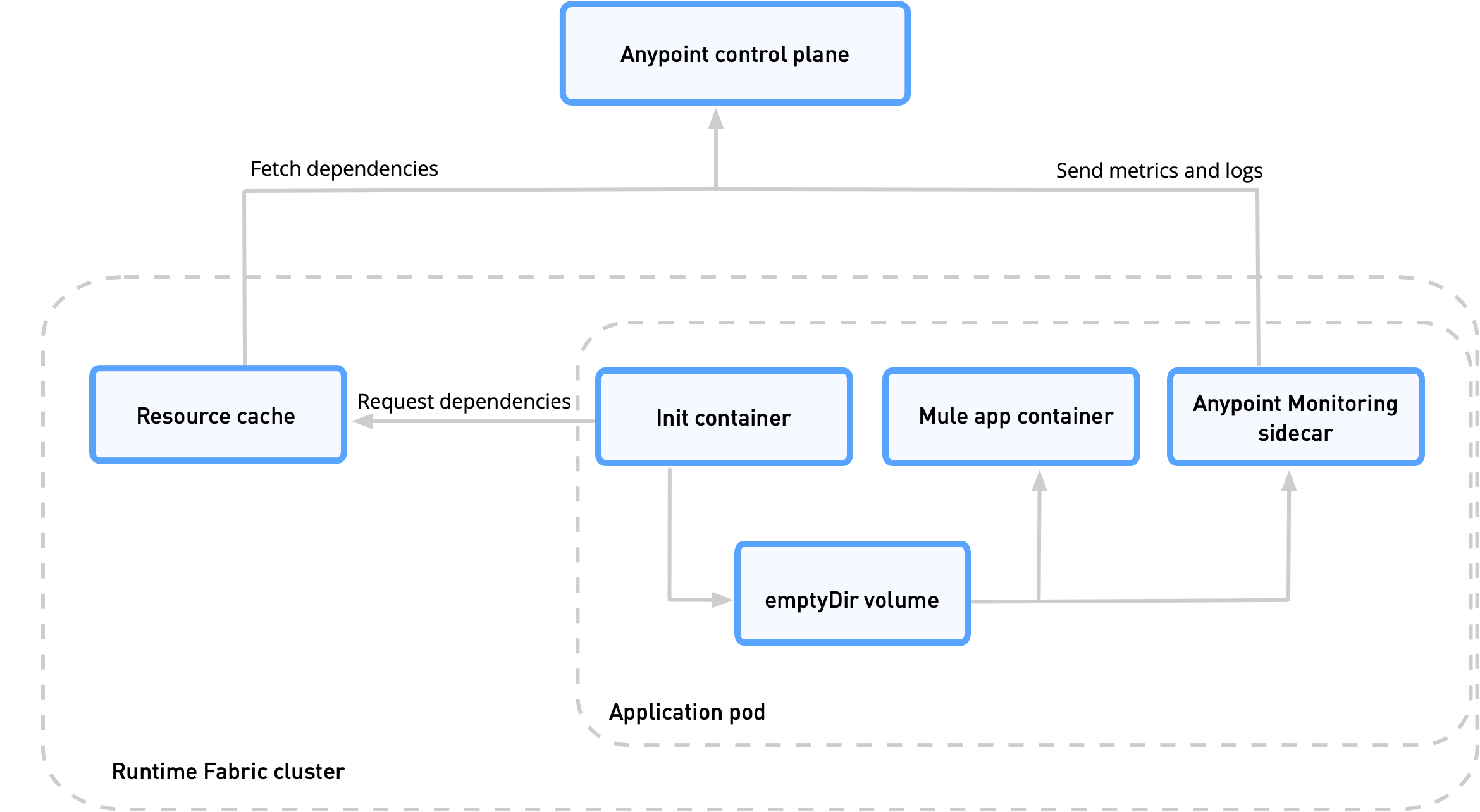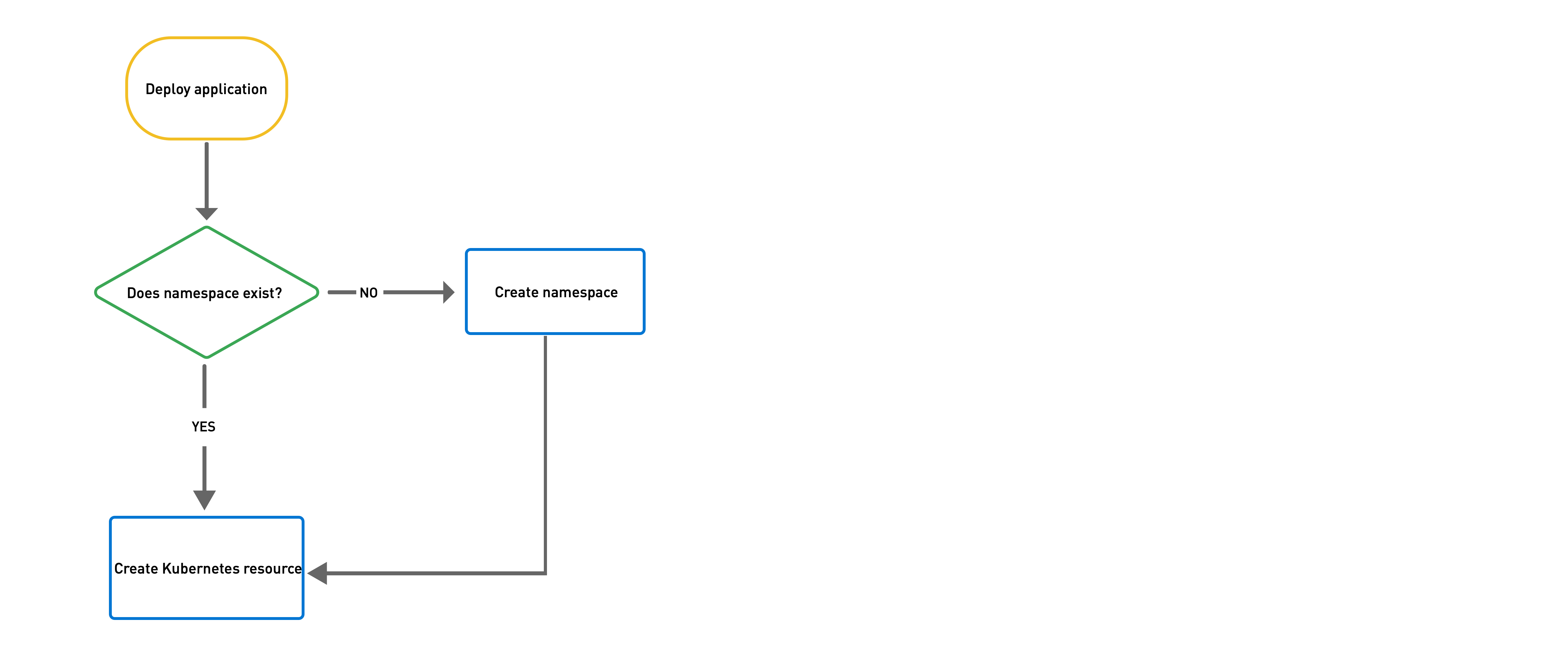
Anypoint Runtime Fabric Overview
Anypoint Runtime Fabric enables you to deploy Mule applications and API proxies to a Kubernetes cluster that you create, configure, and manage.
If you work in public clouds and have some level of expertise in managing a Kubernetes cluster, Runtime Fabric supports:
If you prefer to standardize your own bare-metal solutions using public K8s distributions, depending on your affinity to public clouds and in-house Kubernetes expertise, the following self-managed Red Hat OpenShift offerings can enable both On-Prem and public cloud bare-metal solutions:
Some capabilities of Anypoint Runtime Fabric include:
-
Isolation between applications by running a separate Mule runtime server per application.
-
Ability to run multiple versions of Mule runtime server on the same set of resources.
-
Scaling applications across multiple replicas.
-
Automated application fail-over.
-
Application management with Anypoint Runtime Manager.
Anypoint Runtime Fabric as a Shared Responsibility
The successful operation of Anypoint Runtime Fabric is a shared responsibility. It is critical to understand which areas you provide and manage and which areas MuleSoft provides.
The following image illustrates different MuleSoft and customer responsibilities for Anypoint Runtime Fabric instances:

MuleSoft Provided
MuleSoft provides the Runtime Fabric agent, Mule runtime engine (Mule), and other dependencies used to deploy Mule applications. The Runtime Fabric agent deploys and manages Mule applications by generating and updating Kubernetes resources such as deployments, pods, Replicasets, and ingress resources.
Runtime Fabric Core Services
Anypoint Runtime Fabric and its underlying components run as Kubernetes deployment objects in EKS, AKS, GKE, or RedHat OpenShift environments. You manage the objects via Anypoint Platform.
Linux-based operating systems are required for all nodes that run Runtime Fabric components in Kubernetes clusters.
-
The Runtime Fabric Agent
The Runtime Fabric agent is deployed as a pod in the cluster and communicates with the control plane via an mTLS outbound connection established at startup.
The agent is event-driven. When an application state change generates a Kubernetes event, the agent sends metadata describing the current state of the application to the control plane. Kubernetes events include application pod starts, updates, or restarts.
The agent also listens for incoming requests from the control plane. When the agent receives a message from the control plane, the agent makes changes to the Kubernetes resources specified in the message. Such changes include creating a new application, updating an existing application, or deleting an application.
-
Mule cluster IP service
Provides an API that Mule applications use to discover their peers inside the cluster.
-
Resource cache
Provides a cluster-local cache of application dependencies.
These services are isolated within the core Runtime Fabric installation namespace and replicas. These services do not multiply as applications or nodes increase.
Application Services
Runtime Fabric installs the following application services only when they are configured by users:
-
Persistence Gateway: Provides a persistent ObjectStore v2 interface to Mule applications (Replication configured by user)
-
Anypoint Monitoring sidecar: For monitoring and logging (One sidecar deployed per application replica)
Customer Managed
Customers are responsible for provisioning, configuring, and managing the Kubernetes cluster used for Runtime Fabric. Additional configuration used to set up or enable capabilities on the Kubernetes cluster, such as those listed below, are also the customer’s responsibility to manage:
-
Ingress controller and Customizations to Ingress resources
-
External load balancing
-
Log forwarding
-
Monitoring
-
Network ports, NAT gateways, and proxies
-
Host runtime and networking
-
Provisioning and management of the Kubernetes environment. This requires assistance from the following teams in your organization:
-
IT team to provision and manage the infrastructure
-
Network team to specify allowed ports and configure proxy settings
-
Security team to verify compliance and obtain security certificates
-
How Application Deployments Work in Anypoint Runtime Fabric
When you deploy an application in Anypoint Runtime Fabric, the following occurs:
-
You use Runtime Manager to trigger the application deployment.
-
The Runtime Fabric agent in the target cluster receives a request to deploy the application.
-
Runtime Fabric assigns the application to an existing namespace or creates a new namespace if necessary.
-
Runtime Fabric generates the appropriate Kubernetes resources, including a deployment, ConfigMap, secrets, services, and ingress.
-
If the Kubernetes deployment resource includes an init container, it fetches dependencies from the Runtime Fabric resource cache.
-
If the resource cache doesn’t contain required dependencies, Runtime Fabric fetches them from the control plane and adds them to the resource cache.

Assigning Namespaces in Anypoint Runtime Fabric
Each application is deployed into a Kubernetes namespace based on the application’s environment.
-
Runtime Fabric searches for a namespace with the label
rtf.mulesoft.com/envId=<ANYPOINT_ENVIRONMENT_ID>. -
If Runtime Fabric can’t find that label, it searches for a namespace with the name
<ANYPOINT_ENVIRONMENT_ID>. -
If Runtime Fabric can’t find that namespace, it creates a new namespace called
<ANYPOINT_ENVIRONMENT_ID>and adds the labelrtf.mulesoft.com/envId=<ANYPOINT_ENVIRONMENT_ID>.

Monitoring Application Deployments
The Runtime Fabric agent monitors Kubernetes Deployments labelled with rtf.mulesoft.com/id. When Kubernetes updates the state of the deployment, the agent sends that update to the control plane. See Logs and Monitoring for addtional information.
Requirements for Runtime Fabric
The following descriptions provide you with the general requirements for running Anypoint Runtime Fabric.
Kubernetes Support
Runtime Fabric requires a Kubernetes cluster that is provisioned and operational. Verify if your environment is correctly configured using the rtfctl command-line utility. See Install Runtime Fabric.
See the release notes for your major or minor version of Runtime Fabric for a list of supported Kubernetes versions.
Supported Architectures
Anypoint Runtime Fabric requires worker nodes that use the x86/x64 architecture. ARM-based architectures are not supported.
Operating Systems
Anypoint Runtime Fabric supports any Linux-based operating system supported by Amazon EKS, AKS, GKE, or RedHat OpenShift.
Nodes and Resources
In general, you should follow the best practices provided by your Kubernetes vendor to ensure availability and simplify the administration of your infrastructure.
Follow best practices by installing Runtime Fabric in an environment with a minimum of two nodes each having the following resources:
-
Minimum of two CPU cores
-
At least 15 GiB of RAM
-
At least 250 GiB of available disk space
Adjust the number of nodes and amount of resources allocated according to the amount and type of workload you run on each Anypoint Runtime Fabric instance.
Runtime Fabric ClusterRole Access
The following Runtime Fabric ClusterRoles create and read data stored in Kubernetes secrets:
-
am-log-forwarder -
rtf:agent -
rtf:certificate-renewal -
rtf-restricted -
rtf:cluster-status -
rtf:install -
rtf:persistence-gateway-clro-read-only -
rtf:upgrade -
rtf:mule-clusterip-service
Anypoint Platform Roles and Permissions
To successfully use Anypoint Runtime Fabric, your Anypoint Platform account must have the following permissions enabled:
-
To manage permissions for Anypoint Platform users, you must have the ability to use Anypoint Access Management.
-
To deploy and manage applications ensure you have:
-
The ability to use Anypoint Runtime Manager
-
The Exchange Contributors permission enabled for your Anypoint Platform account
-
The Read Applications and Read Runtime Fabric permissions, which are needed to view all applications on the Applications page in Runtime Manager
-
-
To use Runtime Fabric, you must have the Organization Administrators permission or the Manage Runtime Fabrics permission for the corresponding environments.
-
To delete Runtime Fabric instances, administrators need the Manage Runtime Fabrics permission at the organization level.
Network Configuration
Anypoint Runtime Fabric requires an IT administrator to configure network ports, hostnames, and certificates to function correctly. See Configuring Your Network to Support Runtime Fabric.
Ingress Controller
Runtime Fabric supports any ingress controller that is compatible with your Kubernetes environment and supports a deployment model where a separate ingress resource is created per application deployment. In general, most off-the-shelf ingress controllers support this model.
|
The ingress controller included with GKE provisions a separate HTTP load balancer per application by default. Before using the ingress controller provided by GKE, learn more about its behavior, exploring workarounds, or using another ingress controller if this behavior is undesirable. See the following KB article |
Logs
Anypoint Monitoring provides access to log data for applications deployed to Runtime Fabric. To access logs with Anypoint Monitoring, you need the Anypoint Integration Advanced package or a Titanium subscription to Anypoint Platform.
Applications deployed on Runtime Fabric direct logs to stdout. The container runtime collects these logs and writes them to a file. The storage location of this file depends on your container runtime and configuration. Refer to the documentation for your Kubernetes environment for details.
External Log Forwarding
Anypoint Runtime Fabric does not include external log forwarding. You are responsible for installing, configuring, and managing an external log forwarder. You can use any external log forwarding agent that is compatible with your Kubernetes environment running on Amazon EKS, AKS, or GKE. Common log forwarding agents include:
-
Splunk Connect for Kubernetes
-
Fluentbit
Runtime Fabric also supports Log4j appenders.
Monitoring
Anypoint Monitoring provides metrics for applications and API gateways deployed to Runtime Fabric.
To collect metrics, Anypoint Monitoring sidecars run in all applications deployed to Runtime Fabric. See Monitor Applications Deployed to Runtime Fabric for details, including how to enable or disable monitoring.
Runtime Fabric does not provide support for integrating third-party monitoring solutions.
Feature Support List for Runtime Fabric
The following table lists supported and non-supported features.
| Feature | Status |
|---|---|
Support for deploying Mules and API Gateways |
Supported |
Kubernetes and Docker |
Not included. Provide your instances of Kubernetes and Docker via Amazon EKS, AKS or GKE clusters. |
Installing on any Linux distribution |
Supported |
Node auto-scaling |
Supported using AWS, Azure, Google Cloud, or RedHat OpenShift functionality |
External log forwarding |
You must provide an external log forwarding service |
Internal load balancer |
You must provide an internal load balancer (Ingress Controller) |
Anypoint Security Edge |
Not supported |
Anypoint Security Tokenization |
Not supported |
Ops Center |
Not Included |
Anypoint Runtime Fabric and Standalone Mule Runtimes (Hybrid Deployments)
Hybrid deployments of Mule applications require you to install a version of the Mule runtime on a server and deploy one or more applications on the server. Each application shares the Mule runtime server and the resources allocated to it. Other resources such as certificates or database connections may also be shared using domains.
Anypoint Runtime Fabric provisions resources differently. Each Mule application and API gateway runs within its own Mule runtime and in its own container. The resources available to the container are specified when deploying a Mule application or API proxy. This enables Mule applications to horizontally scale across nodes without relying on other dependencies. It also ensures that different applications do not compete with each other for resources on the same node.



